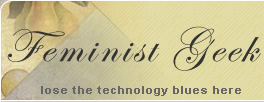Home >
The web offers an unparalleled potential to communicate with others anywhere in the world any time of the day or night. Web communication tools can be used in teaching, for collaborative research and dialogue, and/or as professional or personal interactive forum. This section of Feminist Geek explore the variety of communication tools available to scholars to facilitate community building ~ of historic interest now. ;)
synchronous tools -
real-time communication
Synchronous communication tools let you communicate with others at the same time. They are the computer equivalent of telephone communication.
Advantages - immediacy; some degree of privacy; can be recorded and reviewed.
Disadvantages - sometimes lends a false sense of intimacy; can be difficult to schedule; can be recorded and shared.
Below are brief descriptions of synchronous web communication tools. Click on the tool name to learn more about it.
chat
one of the oldest form of "live" communication still used in the early 21st-century. Chat is real-time communication between two or more individuals using a computing by "typing" thoughts in a shared web environment most easily visualized as an online "room". Many networks and online services provide chat tools.
instant messaging (IM)
another one of the older forms of "live" communication, IM is text-based real-time communication between two (or more) individuals in a private chat environment. Originally available only on online services like AOL, current IM programs are web based with "buddy lists" that alert you when someone you know is online. Read more about instant messaging here.
web conferencing
also known as videoconferencing, web conferencing allows participants to hold a virtual conference that includes video and sound as well as typewritten words - and sometimes more, for example, sharing one's computer desktop with other participants. Macromedia's Breeze Live is an one of the best enterprise-level web conferencing tools geared toward higher education institutions. Apple's iChat AV provided individuals with the right equipment for smaller scale, less expensive method of limited web conferencing in 2002.
moos and muds
MOOs (Multi-User Object Oriented systems) and MUDs (Multi-User Domain/Dimension) are visually rich web environments that were popular during the 1990s. You can (maybe) still read more about the purpose of MOOs here.
asynchronous tools
communicating when convenient
Asynchronous communication tools let you communicate with others at different times, when it is convenient. These tools override the constraints of time zones and allow for easy global communication. In a sense, they are the electronic equivalent of snail mail (letters sent via a postal service), but the delivery is so much faster and free. In another sense, they are similar to voice-mail messages.
Advantages -
extremely convenient; varying degrees of privacy are possible; can be saved, replied to, shared.
Disadvantages - illusion of privacy; heightened expectations for response speed; information overload.
Below are brief descriptions of asynchronous web communication tools. Click on the tool name to learn more about it.
wiki
The simplest online database that could possibly work."
"Wiki is a piece of server software that allows users to freely create and edit Web page content using any Web browser. Wiki supports hyperlinks and has a simple text syntax for creating new pages and crosslinks between internal pages on the fly." from What is a wiki? by Wiki.org
Example - Wikipedia, the free encyclopedia
Wiki is unusual among group communication mechanisms in that it allows the organization of contributions to be edited in addition to the content itself.
Wiki software is available as a component of some learning environments / course management systems (i.e., Sakai) and some commercial web hosting services.
blogs (weblogs)
a web site that contains posts published in reverse chronological order. Some call this an "easy web site" because the software is simple to set up and use, and allows for comments about posts, emailing and archiving posts, links, photos, information about the blog owner, etc. Although weblogs began in the mid 1990s, they have grown in popularity in the 21st century. Find out more about blogs here. Read the FeministGeek blog.
email discussion lists
a popular communications medium for historians, email discussion lists allow a group of people who are list subscribers to send and receive email to the entire group automatically. Read more about email discussion lists and email overload here.
usenet newsgroups
One of the oldest asynchronous communication tools, these are themed Internet message boards, a threaded discussion system with a wide variety of topics. Messages posted on one system are eventually distributed throughout the Usenet network. There are thousands of newsgroups. They are accessed and read with an email program. For more information about Newsgroups, see Lifehacker's How to Get Started with Usenet in Three Simple Steps.
web-based discussion boards
Similar to Usenet newsgroups, these are web-based, threaded discussion boards that are not linked to other discussion boards.
This page is due for a major update. Look at it as a piece of web history - SK
